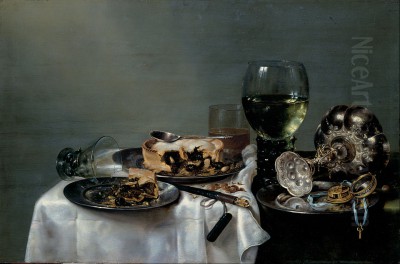
The Dutch Golden Age, spanning roughly the 17th century, was a period of extraordinary artistic flourishing in the Netherlands. Freed from Spanish rule and buoyed by economic prosperity driven by trade, the Dutch Republic saw an unprecedented demand for art that reflected its values, wealth, and daily life. Within this vibrant milieu, still life painting emerged as a major genre, and among its most accomplished practitioners was Willem Claesz. Heda, a painter whose subtle mastery of light, texture, and composition continues to captivate viewers centuries later.
A Life in Haarlem: Early Years and Artistic Formation
Willem Claesz. Heda was born around 1594 or 1595, likely in Haarlem, the city where he would spend his entire life and career. He passed away in Haarlem in 1680, living through much of the Dutch Republic's most dynamic period. While details about his earliest training remain scarce, it is known that he initially explored other genres, including religious scenes and portraiture. However, he soon dedicated himself almost exclusively to still life painting, the field in which he would achieve lasting fame.
His artistic development likely occurred within the active artistic community of Haarlem. Art historians suggest he may have been influenced by or even studied with Floris van Dijck or Floris van Schooten, earlier Haarlem painters who specialized in laid tables laden with food and fine wares. Van Schooten, in particular, is noted for his influence on the compositional structures and subject matter explored by Heda and his contemporaries. Heda's commitment to Haarlem is further evidenced by his long-standing membership and active role in the city's Guild of St. Luke, the professional organization for painters and other craftsmen. He served in various capacities within the Guild, including positions like dean and headman, indicating the respect he commanded among his peers.
The Emergence of the Monochrome Style
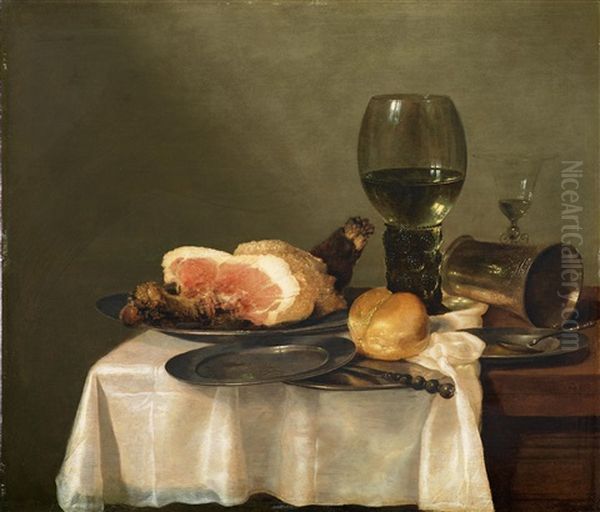
Heda, alongside his slightly older Haarlem contemporary Pieter Claesz, became a leading exponent of a particular style of still life painting that emerged in the late 1620s and dominated the 1630s: the monochrome still life, often referred to as banketjes (banquet pieces) or, more specifically, ontbijtjes (breakfast pieces). This style represented a significant departure from the brightly coloured, additive compositions of earlier Flemish and Dutch still life painters like Clara Peeters or Osias Beert.
The monochrome approach, as pioneered by Heda and Claesz, involved a deliberately restricted and subtle palette, dominated by tones of grey, brown, green, and metallic whites and yellows. This limited colour range shifted the focus away from vibrant hues towards the sophisticated rendering of texture, form, and, crucially, the play of light across different surfaces. These paintings were not truly monochromatic in the modern sense but achieved a remarkable tonal harmony and atmospheric unity through their subdued colour schemes. This refinement appealed to the tastes of the increasingly sophisticated Dutch burghers.
A Master of Texture, Light, and Reflection
Heda's genius lay in his extraordinary ability to capture the tactile qualities of objects and the ethereal effects of light. His paintings are meticulous studies in surface and reflection. He rendered the cool smoothness of pewter plates, the delicate transparency and reflective sheen of glassware (often intricate Roemer wine glasses or tall flutes), and the gleaming highlights on silver goblets or ornate vessels with uncanny realism. The textures of food were equally well-observed: the crumbly nature of bread, the glistening surface of oysters, the rough peel of a half-eaten lemon, or the flaky skin of a herring.
Light is paramount in Heda's work. It typically enters the scene from the left, illuminating objects with a soft, diffused glow. He masterfully depicted how light interacts with different materials – absorbing into rough fabrics like tablecloths, reflecting sharply off polished metal, and refracting through glass, often casting subtle shadows and creating a palpable sense of space and depth. The interplay between light and shadow defines forms, creates atmosphere, and guides the viewer's eye through the composition. His handling of reflections, particularly on silver and glass, where distorted images of the studio window or surrounding objects can sometimes be discerned, adds another layer of verisimilitude and technical brilliance.
The Ontbijtje: Composing the Breakfast Piece
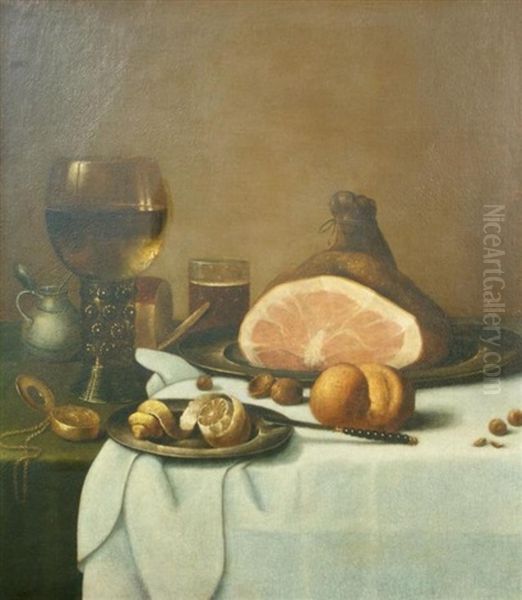
The ontbijtje, or breakfast piece, was Heda's signature genre for much of his career. These paintings typically depict the remnants of a simple meal, arranged seemingly casually on a tabletop partially covered by a white or green cloth. Common elements include bread, nuts, oysters, a pie (often blackberry or meat), a half-peeled lemon (its spiral peel often dangling elegantly over the table edge), pewter plates, knives, and various drinking vessels. While termed "breakfast pieces," the meals depicted often resemble a light midday or late-morning snack rather than an early morning meal by modern standards.
Despite their apparent informality, Heda's compositions are carefully constructed. He often employed diagonal lines – a tilted plate, a fallen goblet (beker), a knife placed at an angle – to create a sense of dynamism and depth, leading the eye into the scene. Objects are frequently overlapped to enhance the illusion of space. While maintaining an overall balance, Heda avoided rigid symmetry, preferring arrangements that felt natural yet harmonious. The rumpled tablecloths, overturned vessels, and half-eaten food contribute to a sense of immediacy, as if someone has just stepped away from the table. This careful balance between studied composition and apparent casualness is a hallmark of his style.
Layers of Meaning: Vanitas and the Pronkstilleven
Beyond their technical brilliance and aesthetic appeal, Heda's still lifes often carry symbolic weight, reflecting the moral and religious preoccupations of 17th-century Dutch society. His earlier works, sometimes explicitly categorized as Vanitas paintings, directly address the theme of life's transience and the vanity of earthly possessions and pleasures. A notable example, sometimes dated to 1628, includes traditional Vanitas symbols like a skull, an overturned and empty Roemer glass, a snuffed candle or oil lamp, and perhaps a watch, all reminding the viewer of mortality and the fleeting nature of time.
Even the seemingly straightforward ontbijtjes can be interpreted through a Vanitas lens. The simple fare might suggest moderation, a virtue prized in Calvinist Holland. However, the inclusion of luxury items – silver goblets, imported lemons, oysters (considered an aphrodisiac) – hints at worldly wealth and potential indulgence. The broken or overturned glasses, the unfinished meal, and the perishable nature of the food itself can serve as subtle reminders that earthly pleasures are temporary and that life itself is fragile. The half-peeled lemon, a recurring motif, was often associated with temperance (due to its sourness tempering sweetness) but also with the bitterness that can accompany life's pleasures.
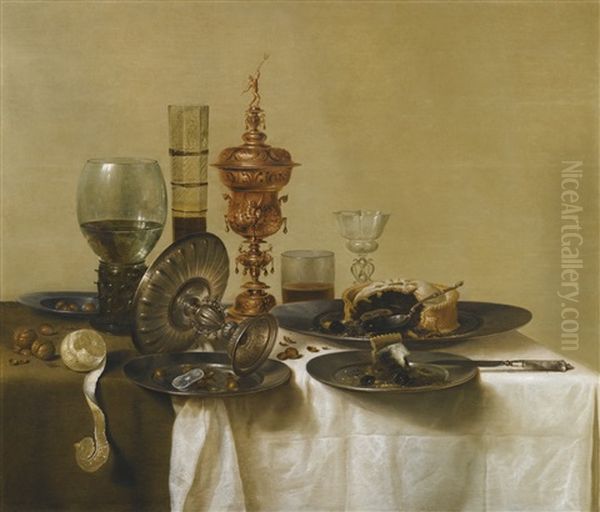
As his career progressed, particularly from the 1640s onwards, Heda's compositions sometimes became more elaborate and opulent, incorporating more luxurious items like ornate silver-gilt cups, nautilus shell goblets, and richer fabrics. These later works align more closely with the pronkstilleven (sumptuous or ostentatious still life) genre, which became increasingly popular in the latter half of the Golden Age, practiced by artists like Willem Kalf and Abraham van Beyeren in Amsterdam and Utrecht. Yet, even in these richer displays, a sense of restraint and the underlying Vanitas theme often persist, distinguishing Heda's work from the more exuberant displays of pure luxury found in some other pronkstilleven painters.
Heda's Workshop, Students, and the Haarlem Context
As a respected master in Haarlem, Willem Claesz. Heda operated a workshop and trained apprentices. His most notable student was his own son, Gerrit Willemsz. Heda, who became a master in the Haarlem Guild in 1642. Gerrit worked closely with his father, and his style is often remarkably similar, focusing on the same types of monochrome still lifes. This similarity has led to significant attribution challenges for art historians, with some works previously assigned to Willem now being attributed to Gerrit, or considered collaborative efforts. Distinguishing their hands often relies on subtle differences in brushwork or compositional preferences.
Another documented pupil was Maerten Boelema de Stomme, known for his competent still lifes that clearly show Heda's influence. Heda's workshop was part of the thriving artistic environment of Haarlem, a city that rivaled Amsterdam and Delft in artistic production during the Golden Age. He worked alongside prominent figures like the aforementioned Pieter Claesz, the great portraitist Frans Hals, the genre painter Judith Leyster, and the architect and painter Salomon de Bray. The exchange of ideas and stylistic influences within the Haarlem school was undoubtedly fertile ground for Heda's development.
His influence extended beyond his direct pupils. His sophisticated compositions and mastery of monochrome tonalities impacted other still life painters across the Netherlands. Artists working in other centers, such as Jan Davidsz. de Heem (active in Utrecht and Antwerp) or later Amsterdam painters like Jan Janszoon van Uylenburgh, show awareness of the stylistic innovations pioneered in Haarlem by Heda and Claesz. Even major figures outside the still life genre, like Rembrandt van Rijn or Jan Lievens in Leiden and Amsterdam, or Johannes Vermeer in Delft, were part of the broader artistic conversation of the Dutch Golden Age to which Heda contributed significantly within his chosen specialization. The flower painter Rachel Ruysch, though working later and in a different subgenre, represents the continued vitality of Dutch still life painting.
Later Career and Stylistic Evolution
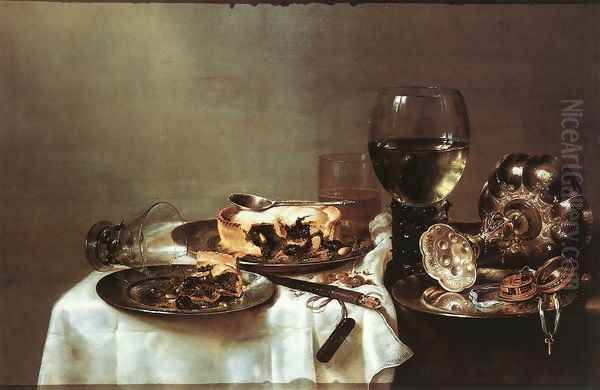
Willem Claesz. Heda enjoyed a long and productive career, remaining active into his eighties. While the core elements of his style remained consistent – the focus on texture, light, and balanced composition – subtle shifts occurred over the decades. As mentioned, the 1640s saw a move towards slightly more elaborate compositions and the inclusion of more valuable objects, aligning with the broader trend towards pronkstilleven. The scale of his paintings sometimes increased, and the arrangements could become more complex, featuring taller stacks of objects or more dynamic interplay between forms.
However, some sources also suggest a move towards greater simplicity and elegance in his very late works, perhaps returning to slightly less cluttered compositions but retaining the exquisite rendering of surfaces. Throughout his career, his technical skill remained exceptionally high. His signature appears on paintings dated as late as the 1660s, demonstrating his continued activity well into old age. His consistent output over several decades cemented his reputation as one of the foundational figures of Dutch still life.
Legacy, Rediscovery, and Enduring Appeal
During his lifetime, Willem Claesz. Heda was a highly regarded artist. The Haarlem minister and poet Samuel Ampzing praised him in a poem in 1628, mentioning him alongside Salomon de Bray as one of the city's esteemed painters. His works were collected by discerning patrons in the Netherlands and likely exported elsewhere in Europe. However, like many Dutch Golden Age masters specializing in still life, his fame somewhat diminished during the 18th and early 19th centuries, when academic taste often favored history painting and portraiture.
His critical rediscovery owes much to the work of 19th-century art critics and historians, particularly the influential French critic Théophile Thoré-Bürger (who also famously rediscovered Vermeer). Thoré-Bürger and others recognized the unique aesthetic qualities and technical mastery of Heda's work, helping to restore his reputation and secure his place in the canon of Dutch art.
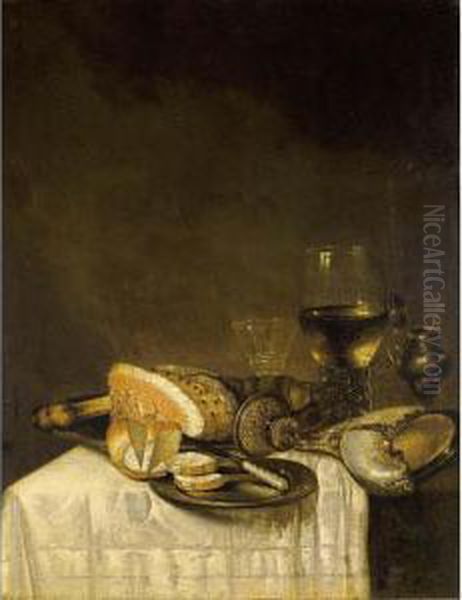
Today, Willem Claesz. Heda is celebrated as one of the undisputed masters of 17th-century still life painting. His works are prized possessions in major museums worldwide, including the Rijksmuseum in Amsterdam, the Mauritshuis in The Hague, the Louvre in Paris, the National Gallery in London, and the Metropolitan Museum of Art in New York. His paintings are admired not only for their stunning realism and technical virtuosity but also for their quiet elegance, subtle atmospheric effects, and the intriguing layers of meaning embedded within their seemingly simple subjects. He transformed the humble breakfast table into a stage for profound explorations of light, texture, composition, and the transient nature of earthly existence. His legacy lies in his pivotal role in developing the monochrome still life and in creating works of enduring beauty and quiet contemplation.